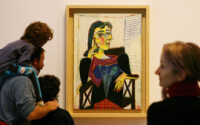Ronald S. Lauder Sells Philip Johnson Mini-Home for Nearly $20 M.
A small, two-story modernist townhouse designed by Philip Johnson on 52 street in Manhattan—lodged between a 15-story condo and an old-school brownstone—has sold for $19.999 million. The building, previously owned by Ronald S. Lauder, billionaire philanthropist, collector, and partial heir to the Estée Lauder cosmetics company, sold to an limited liability company called Ludo USA, according to city records.
The building was never listed, and the sale was so secretive that not even New York City real estate watchdog Curbed, which first reported the sale, knew it was coming. According to Curbed, this is the second time Lauder unloaded the home, which he bought in 1989; in 2000, he sold the home at auction to the London-based art dealer Anthony d’Offay.
The house is as connected to New York’s art world as the Whitney or the MoMA. In 1950, John D. Rockefeller III’s wife, Blanchette, commissioned it from Philip Johnson. According to a T Magazine story, she needed a place to keep her modern art collection, which included works such as Alberto Giacometti’s Man Pointing and Robert Motherwell’s The Voyage. Johnson designed the home not as a living space but rather as a combination gallery, artist’s salon, and entertainment space.
However, the home isn’t the most practical to live in. There are two rooms on the first floor with glass walls that border an open-air pond. In the original design, two unheated bedrooms were added, according to Johnson, only because the building would look ridiculous without a second floor. There was no kitchen though true to purpose, there was a bar which was attended to by a butler. (A kitchen was eventually added to the basement.)
In 1958, Rockefeller donated the house to MoMA, which used the space as an extension of the museum where potential donors could be wooed, artists entertained “Modernism in its purest and most impressive form” could be displayed, according to the New York Times.
From 1971-1979 Johnson and his partner David Whitney leased the home from its then owner, Mary Gay Labrot Leonhardt, widow of the journalist Robert Sharrod. The architect moved in and decorated the space with rotating selections from his collection of Roy Lichtenstein’s and Frank Stella’s, twice a year holding court for guests like Andy Warhol and Fran Leibowitz.



